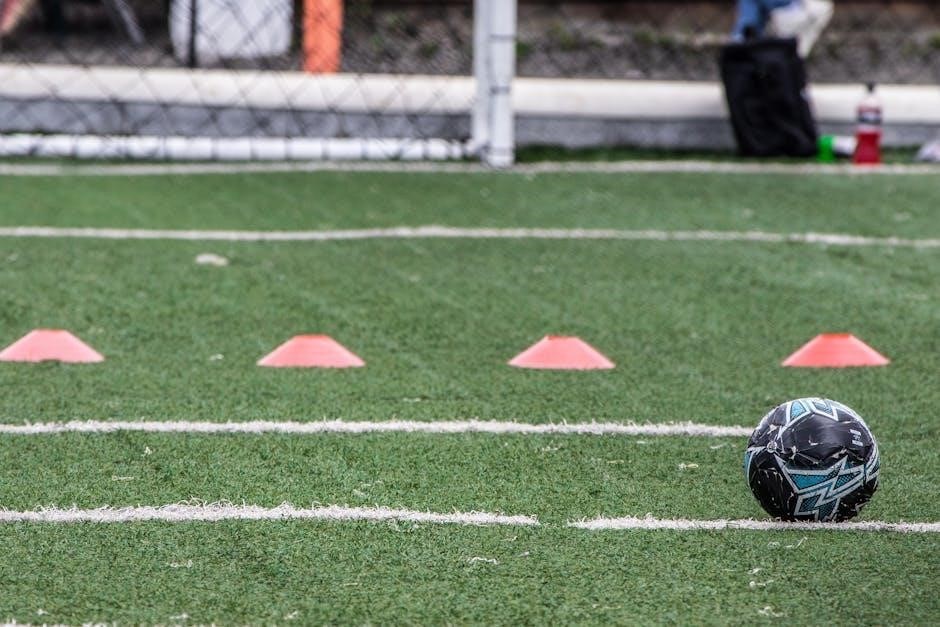In soccer, superior footwork is vital․ This guide introduces a variety of PDF footwork drills designed to elevate your soccer capabilities․ These resources offer structured exercises to improve agility, ball control, and overall performance on the field․
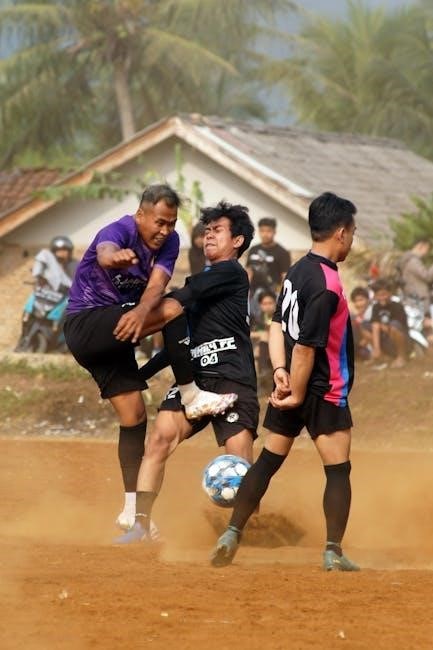
Benefits of Using PDF Footwork Drills
PDF footwork drills offer structured training plans, enhancing speed and agility․ Improved ball control is another key benefit, alongside convenient access for practice anytime, anywhere․ These drills are essential for skill development․
Improved Speed and Agility
Soccer PDF footwork drills are designed to boost a player’s speed and agility on the field; Ladder drills and cone drills, commonly found in these resources, help enhance foot speed and change-of-direction skills․ Regular practice with these drills contributes to quicker reaction times, improved acceleration, and the ability to navigate tight spaces with greater ease․ This leads to a more dynamic and effective playing style, making players more challenging for opponents to defend against․ These workouts are essential․
Enhanced Ball Control
PDF footwork drills significantly contribute to enhanced ball control, a fundamental aspect of soccer․ These drills incorporate exercises that require players to manipulate the ball with various parts of their feet, improving their touch and precision․ Regular practice refines a player’s ability to dribble, pass, and receive the ball effectively under pressure․ Mastering these techniques leads to greater confidence and composure on the field, enabling players to maintain possession and make better decisions during gameplay․ These exercises are great for all ages․
Convenient Access and Practice
The beauty of PDF footwork drills lies in their convenient accessibility and ease of practice․ These resources can be downloaded and accessed on various devices, allowing players to practice anytime, anywhere․ The structured format of PDFs makes it easy to follow instructions and track progress․ This accessibility promotes consistent practice, which is crucial for skill development․ Whether at home, in the park, or on the training ground, players can utilize these drills to hone their footwork and elevate their game through regular training․ These drills are great for all ages․
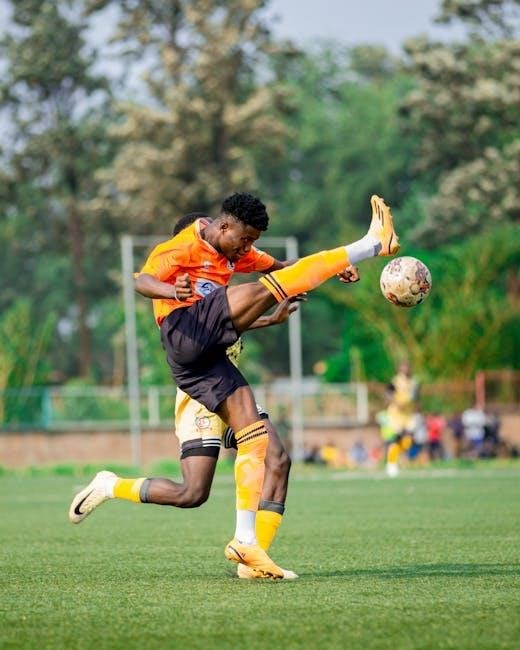
Types of Soccer Footwork Drills in PDF Format
PDF resources offer diverse soccer footwork drills․ These include warm-up drills for preparation, technical drills focusing on ball control, and agility drills to enhance quickness․ These drills help players improve their overall soccer skills․
Warm-up Drills
Warm-up drills are crucial for preparing players for more intense training․ These drills often involve light jogging, dynamic stretching, and basic ball-handling exercises․ The goal is to increase blood flow, improve flexibility, and activate the necessary muscle groups․ Effective warm-up routines reduce the risk of injury and enhance performance during practice or games․ These are a regular part of exercise and training preparation for players of all ages and skill levels․
Technical Drills
Technical drills focus on refining specific soccer skills like passing, receiving, dribbling, and shooting․ These drills emphasize proper technique and repetition to build muscle memory and improve overall ball control․ Technical exercises are designed to enhance a player’s ability to execute skills effectively under pressure․ The drills focus on touching the ball with all parts of the foot, and help meet the demands of the modern game․
Agility Drills
Agility drills are designed to improve a player’s quickness, balance, and coordination on the soccer field․ These drills often involve cone setups, ladder exercises, and shuttle runs to enhance foot speed and change of direction․ Agility drills are crucial for evading defenders, creating space, and reacting swiftly to game situations․ These are great drills to improve balance, body control, co-ordination and foot speed․
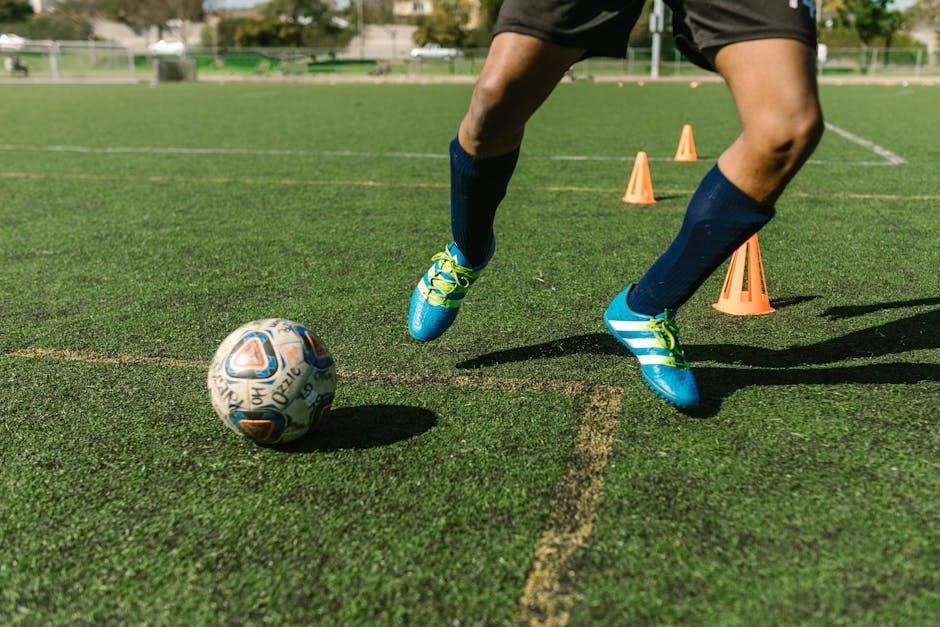
Essential Footwork Skills Covered in PDF Drills
PDF drills encompass crucial skills: dribbling techniques for close control, passing and receiving skills for accurate distribution, and turning skills to evade opponents effectively․ These skills form the core of effective footwork in soccer․
Dribbling Techniques
PDF footwork drills are essential for mastering dribbling techniques, enhancing ball control, and improving a player’s ability to navigate tight spaces on the field․ These drills focus on developing a soft touch, quick foot movements, and the coordination necessary to maintain possession while under pressure․ They often incorporate exercises that require players to use all parts of their feet, improving their overall dribbling proficiency․
Passing and Receiving Skills
PDF footwork drills are invaluable for honing passing and receiving skills․ These exercises emphasize precise foot movements and proper body positioning to control incoming passes effectively․ Drills often incorporate quick touches, changes of direction, and the use of different foot surfaces for accurate distribution․ Regular practice using these resources enhances a player’s ability to make quick decisions and execute efficient passes under pressure, contributing to improved team play․
Turning Skills
Mastering turning skills is crucial in soccer, and PDF footwork drills offer structured methods to improve these abilities․ These drills focus on quick changes of direction, utilizing various parts of the foot to maintain ball control while pivoting․ Exercises often involve cone setups that simulate game-like scenarios, enhancing agility and balance․ Regular practice with these resources enables players to navigate tight spaces, evade defenders, and create scoring opportunities with greater efficiency․
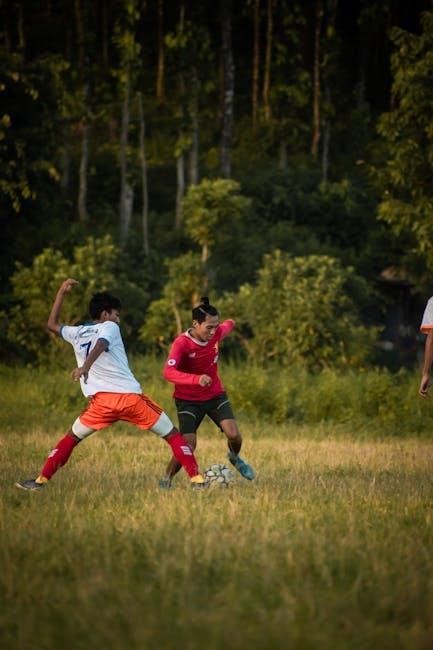
Sample PDF Footwork Drills
Explore practical examples of PDF footwork drills․ These drills include ladder exercises for speed, cone drills for agility, and targeted ball control exercises․ Each drill is designed to enhance specific soccer skills․
Ladder Drills for Foot Speed
Ladder drills are excellent for enhancing foot speed and coordination, crucial elements in soccer․ These drills involve quick, precise movements within the ladder’s rungs, improving agility and reaction time․ Players practice various patterns, like lateral shuffles and forward runs, to develop faster footwork․ The repetition and focus on technique help players become more nimble and efficient on the field, improving their ability to quickly change direction and react to opponents․ Incorporating ladder drills regularly can lead to significant gains in foot speed․
Cone Drills for Agility
Cone drills are essential for developing agility and change of direction skills in soccer․ These drills involve setting up cones in various patterns and maneuvering through them with speed and precision․ Players practice accelerating, decelerating, and changing direction quickly, improving their overall agility on the field․ Common cone drills include slalom runs, shuttle runs, and figure-eight patterns․ Regularly incorporating cone drills into training helps players improve their footwork, balance, and coordination, enabling them to react more effectively in game situations․
Ball Control Exercises
Ball control exercises are crucial for improving a player’s ability to manipulate and retain possession of the ball․ These exercises focus on developing a soft touch, precise passing, and quick reactions․ Drills often involve using different parts of the foot to control the ball in various situations, such as receiving a pass, dribbling through tight spaces, or shielding the ball from opponents․ Regular practice of these exercises enhances a player’s confidence and competence in handling the ball under pressure, leading to better decision-making and overall performance on the field․
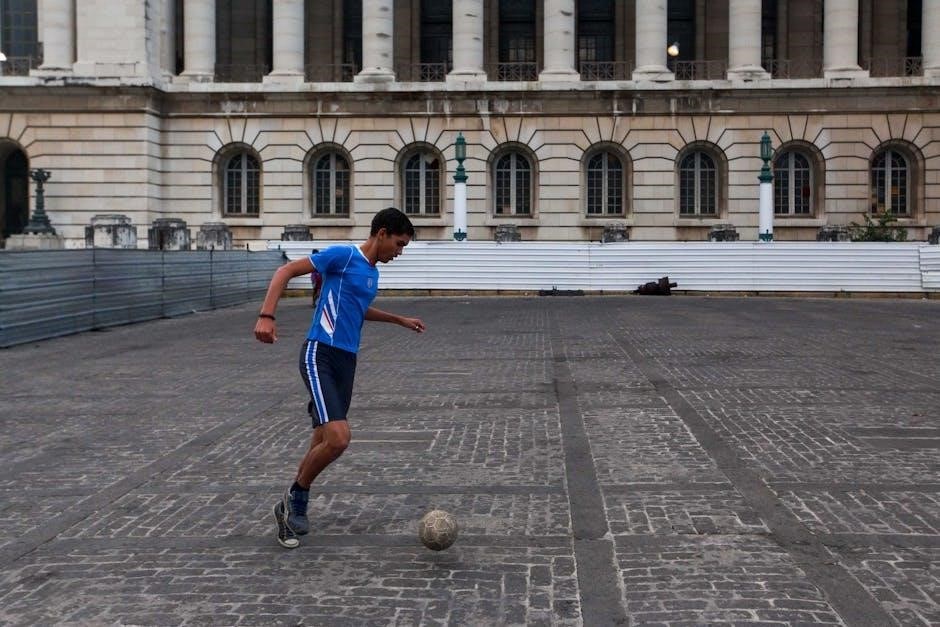
Creating a Footskills Practice with PDF Resources
Crafting an effective footskills practice is easy with PDF resources․ Focus on foundation skills, change of direction moves, and 1v1 techniques․ These drills will develop well-rounded soccer skills for players of all levels․
Foundation Skills
Foundation skills are the cornerstone of soccer excellence, involving basic techniques to control the ball effectively․ These techniques are essential for players aiming to enhance their overall game․ PDF resources offer structured drills focusing on dribbling, passing, and receiving․ Mastering these fundamental skills ensures players can maintain possession, distribute the ball accurately, and create opportunities on the field․ Consistent practice of foundation skills is crucial for player development․
Change of Direction Moves
Change of direction moves are vital for soccer players seeking to evade defenders and create space․ These maneuvers involve quick turns and strategic footwork․ PDF drills focus on mastering various turns, enabling players to swiftly alter their course while maintaining ball control․ Proficiency in change of direction moves enhances a player’s agility and tactical flexibility, making them a more formidable opponent on the field․ Practice these skills diligently to improve game performance․
1v1 Moves
Mastering 1v1 moves is crucial for any soccer player aiming to excel in attacking situations․ These techniques focus on effectively getting past a defender to gain an advantage․ PDF drills offer structured exercises to improve these skills, including feints, step-overs, and quick changes of pace․ Regular practice of 1v1 moves enhances a player’s confidence and ability to create goal-scoring opportunities․ Develop these skills to become a more effective and dynamic player on the field․
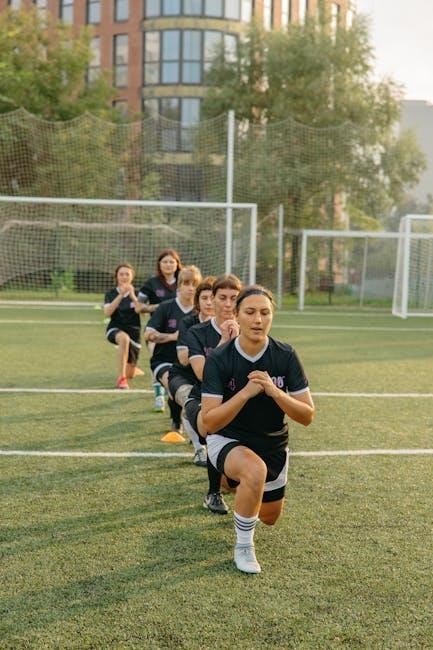
Importance of Daily Footwork Practice
Daily footwork practice is essential for soccer players․ Consistent training enhances ball control, agility, and reaction time․ Even short, focused sessions can lead to significant improvements, making players more effective on the field․
The 7-Minute Daily Footwork Drill
The 7-minute daily footwork drill is a highly effective method for improving soccer skills․ This quick workout, designed to provide approximately 1000 touches, focuses on enhancing agility and ball control․ Incorporating this routine into your daily training can significantly improve your on-field performance․ It is a great way to improve your soccer skills and can easily fit into any schedule․
Footwork Drills for Different Age Levels
Effective footwork drills vary by age․ This section provides appropriate drills for younger players, focusing on basic skills, and drills for advanced players, emphasizing complex techniques․
Drills Suitable for Younger Players
For younger soccer players, footwork drills should emphasize fundamental movement skills and ball familiarity․ These drills often incorporate simple cone exercises, focusing on dribbling with different parts of the foot․ Passing and receiving drills should be introduced in a basic format to build a solid foundation․ The goal is to develop coordination, agility, and a love for the game through fun, engaging activities that promote frequent touches on the ball, setting the stage for future skill development․
Drills for Advanced Players
Advanced players require footwork drills that challenge their existing skills and push them to improve further․ These drills incorporate complex patterns, rapid changes of direction, and techniques like pull back laces and instep control․ Emphasis is placed on decision-making under pressure, replicating game-like scenarios․ Incorporating 1v1 moves and advanced turning techniques are crucial for developing the agility, speed, and ball mastery necessary to excel at higher levels of soccer․
Incorporating Footwork Drills into Team Training
Integrating footwork drills into team training enhances overall performance․ These drills improve agility, coordination, and ball control across the team․ By focusing on both individual skill and team tactics, players become more effective and synchronized․
Warm-up Integration
Integrating footwork drills into the warm-up routine is essential for preparing players physically and mentally․ These drills enhance coordination, agility, and focus before more intense training․ By starting with light footwork exercises, players can improve their reaction time, reduce the risk of injuries, and increase their overall effectiveness during the session․ Including dynamic movements and ball control exercises in the warm-up routine sets the stage for a productive and successful training session․
Skill-Specific Training
Skill-specific training involves incorporating footwork drills that directly correlate with specific soccer skills․ By focusing on dribbling, passing, receiving, and turning, players can refine their technique and improve their overall game performance․ These drills often involve replicating game-like scenarios, allowing players to apply their enhanced footwork in real-time situations․ Tailoring footwork exercises to specific skills ensures that players develop a well-rounded skill set, enhancing their agility, coordination, and decision-making abilities on the field․
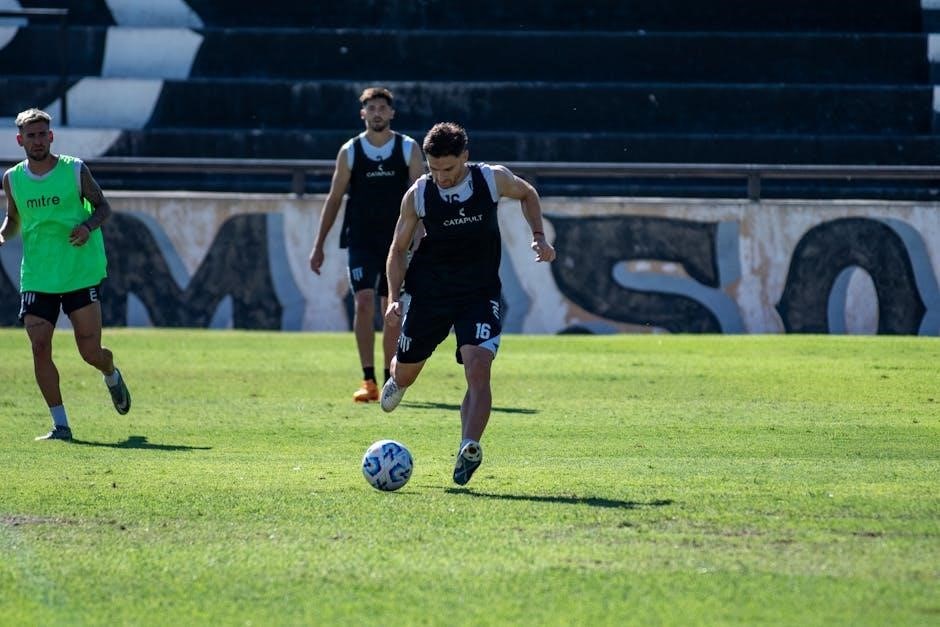
Resources for Finding PDF Soccer Footwork Drills
Numerous online platforms offer PDF soccer footwork drills․ Soccer training websites and coaching books are excellent resources․ These often provide structured programs for players of varying skill levels and experience․
Online Soccer Training Websites
Many online soccer training websites provide a wealth of PDF resources containing footwork drills․ These platforms often feature drills demonstrated through videos and detailed diagrams, making them easy to understand and implement․ Sites like Beast Mode Soccer offer specialized programs focusing on technical development․ These online resources provide structured plans suitable for different skill levels, assisting players in improving their footwork effectively․
Soccer Coaching Books
Soccer coaching books are invaluable resources for finding comprehensive footwork drills in PDF format․ These books often include a wide array of drills, from basic warm-ups to advanced techniques; They typically offer detailed explanations, diagrams, and coaching tips․ Books provide structured training plans suitable for different age groups and skill levels, helping coaches and players systematically improve footwork․ Many also cover tactical aspects, integrating footwork into game situations․

Tips for Effective Footwork Training
To maximize footwork training, prioritize proper technique over speed․ Consistently practice with both feet to develop balanced skills․ Regular, focused sessions are key to improving agility, ball control, and overall soccer performance․
Focus on Technique
Prioritizing correct technique is paramount in footwork training․ Before increasing speed or repetitions, ensure each movement is precise․ This involves mastering the proper foot placement, body posture, and ball contact․ Emphasize quality over quantity, as ingrained technical proficiency translates to superior agility and control during gameplay․ Consistent focus on technique optimizes skill development and minimizes the risk of developing bad habits or injuries․
Use Both Feet
Developing proficiency with both feet is crucial for balanced soccer skills․ Integrate drills that specifically challenge your weaker foot, enhancing coordination and control on both sides of your body․ This ambidexterity expands your options during matches, allowing for unpredictable movements and passes․ Regularly practicing with both feet improves overall agility, reduces reliance on your dominant side, and makes you a more versatile and effective player on the field․
Advanced Footwork Drills and Techniques
Explore advanced soccer footwork through specialized drills in PDF format․ Techniques such as the pull-back laces and pull-back instep will improve ball control and agility․ Master these techniques for exceptional field performance․
Pull Back Laces
The pull-back laces technique is an advanced footwork drill used to quickly change direction and evade defenders․ This move involves using the laces of your shoe to pull the ball back sharply, creating space and opening up new angles for passing or shooting․ Regular practice of this technique enhances a player’s agility, ball control, and overall effectiveness in dynamic game situations․ It’s a crucial skill for modern soccer players․
Pull Back Instep
The pull-back instep move allows players to swiftly alter their direction while maintaining close control of the ball․ This technique is performed by using the inside of the foot to pull the ball back, facilitating a quick turn or change of pace․ Mastering the pull-back instep enhances a player’s ability to deceive opponents, create space, and execute effective attacking maneuvers․ Consistent practice is essential for developing fluidity and precision․
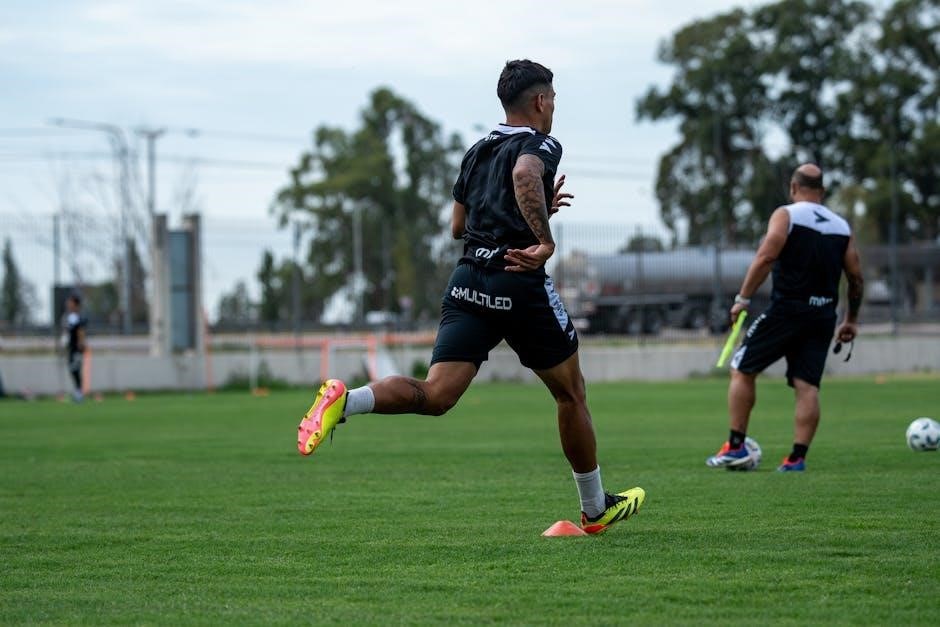
The Role of Footwork in Game Situations
Footwork profoundly impacts game situations, enhancing decision-making and attacking moves․ Quick feet enable players to navigate tight spaces, evade defenders, and exploit opportunities, making footwork a crucial asset for success․
Improving Decision-Making
Enhanced footwork directly contributes to improved decision-making on the field․ With refined agility and ball control, players gain the time and space needed to assess options effectively․ Quicker foot movements allow for faster reactions to changing game dynamics, enabling more strategic passes, shots, and dribbling maneuvers․ Practicing footwork drills sharpens cognitive skills, fostering better anticipation and tactical awareness, ultimately leading to smarter plays․
Enhancing Attacking Moves
Superior footwork is the foundation of effective attacking moves in soccer․ Agile foot movements enable players to execute quick turns, feints, and changes of pace, leaving defenders disoriented․ Enhanced ball control allows for precise dribbling, creating opportunities to penetrate the defense․ Consistent footwork training builds the confidence to take on opponents, opening up scoring chances and improving overall attacking prowess․ Mastering these skills is crucial for dynamic and impactful offensive plays․

